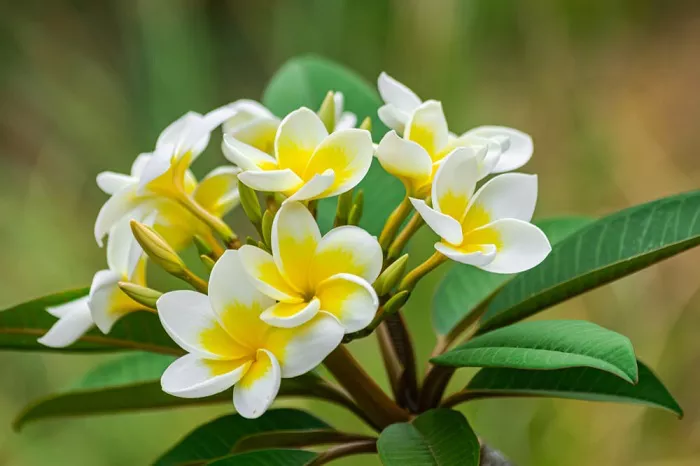Plumeria, with its intoxicating fragrance and vibrant blooms, is a beloved addition to any garden. However, coaxing this tropical beauty into full bloom can sometimes be a challenge. Whether you’re a seasoned gardener or a novice, understanding the specific needs of plumeria is key to enjoying its stunning flowers. In this article, we’ll explore the essential steps and tips to help your plumeria thrive and flower.
Understanding Plumeria‘s Natural Habitat
Plumeria is native to tropical and subtropical regions, thriving in warm climates with plenty of sunlight. To encourage flowering, it’s crucial to replicate its natural environment as closely as possible. Plumeria plants require at least six to eight hours of direct sunlight daily. If you’re growing plumeria in a pot, ensure it’s placed in a sunny spot. For gardeners in cooler climates, consider using a greenhouse or bringing the plant indoors during winter months to protect it from frost.
Soil and Drainage Requirements
Plumeria prefers well-draining soil to prevent root rot. A mixture of equal parts potting soil, perlite, and coarse sand is ideal. This combination ensures proper aeration and drainage. When planting, ensure the root ball is slightly elevated to avoid waterlogging. If you notice water pooling around the base of the plant, it’s a sign that the soil is too dense and needs improvement.
Watering Techniques
Proper watering is essential for plumeria health and flowering. While the plant enjoys consistent moisture during the growing season, it’s crucial not to overwater. Allow the top inch of soil to dry out between waterings. During the dormant season, reduce watering significantly to mimic the plant’s natural rest period. Overwatering can lead to root rot, while underwatering can stress the plant and inhibit flowering.
Fertilizing for Flowering Success
Nutrient-rich soil is vital for plumeria growth and flowering. Use a balanced fertilizer with equal parts nitrogen, phosphorus, and potassium during the early growing season. As the plant enters its flowering phase, switch to a high-phosphorus fertilizer to encourage bud formation. Apply fertilizer every four to six weeks, following the manufacturer’s instructions. Organic options like bone meal or fish emulsion can also provide essential nutrients.
Pruning for Optimal Growth
Pruning is an important aspect of plumeria care. Remove any dead or damaged branches to promote healthy growth. Pruning also helps shape the plant and encourages the development of new flowering branches. The best time to prune is in late winter or early spring, just before the plant begins its active growth phase. Be sure to use clean, sharp tools to avoid damaging the plant.
Pest and Disease Management
Plumeria can be susceptible to pests such as spider mites and mealybugs. Regularly inspect your plant for signs of infestation. If you notice pests, treat the plant with a mild insecticidal soap or neem oil. Proper airflow and sunlight can also help prevent pest problems. Additionally, be vigilant for fungal diseases, which can occur in humid conditions. Ensure your plant is not overcrowded and that the soil is well-draining.
Encouraging Dormancy
In its natural habitat, plumeria experiences a period of dormancy during the dry season. Replicating this dormancy period can help trigger flowering. Reduce watering and stop fertilizing in the fall, allowing the plant to rest. During this time, the plant will focus its energy on root development and prepare for the next growing season. This natural cycle is essential for healthy flowering.
Temperature and Humidity
Plumeria thrives in temperatures between 65°F and 85°F (18°C to 29°C). While it can tolerate some fluctuations, extreme cold or heat can stress the plant. If you live in a region with harsh winters, consider protecting your plumeria by moving it indoors or using frost covers. Additionally, plumeria prefers moderate humidity levels. If your environment is too dry, consider using a humidifier or placing a tray of water near the plant.
Propagation Tips
If you’re looking to expand your plumeria collection, propagation is a great option. Plumeria can be propagated from cuttings, which should be taken from healthy, mature branches. Allow the cuttings to dry for a few days before planting them in well-draining soil. Keep the soil slightly moist until the cutting roots, which can take several weeks. With proper care, your new plumeria plants will soon be on their way to flowering.
Common Challenges and Solutions
Despite your best efforts, you may encounter challenges with your plumeria. One common issue is the plant’s failure to flower. This can be due to insufficient sunlight, improper watering, or lack of nutrients. By addressing these factors, you can encourage your plumeria to bloom. Another challenge is dealing with pests and diseases. Regular monitoring and prompt treatment are essential to maintaining plant health.
Conclusion
With the right care and attention, your plumeria can reward you with its stunning, fragrant blooms. By understanding its natural habitat, providing proper soil, water, and nutrients, and managing pests and diseases, you can create the ideal environment for flowering. Enjoy the beauty and fragrance of your plumeria, and watch as it transforms your garden into a tropical paradise.


